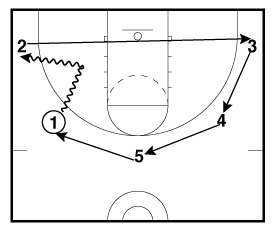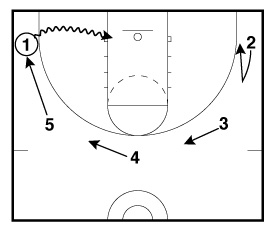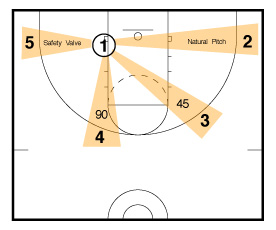06 Jul Bounce Off Drill Series, Part 3: 5 Man Drills
Here is the final installment of Rich Czeslawski's Bounce Off Drill Series. Check out Part 1 and Part 2 - together these three create a progression. You know how much we at Better Basketball love progressions! Rich doesn't just write for the Tribe either, he has his own blog, which is worth spending some time on. After running the 3-Player Drills, we move to our 5-on-0 Bounce Drill, which really reinforces the habit of Circle Movement and allows the player with the ball to work on the Bounce Off technique. We teach our “Bouncers” to reverse dribble (like a defensive slide) with their front shoulder pointed to the rim to protect the ball. Once they get to the new perimeter spot they square their shoulders so they are a threat to pass, shoot, or drive again.5 on 0 Bounce Off Drill
Player 1 bounces from right corner to left corner, and then finishes with a Baseline Drive. Each player is the “Bouncer” once, and then we do the drill starting from the left corner, moving to the right.



 We finish each set with a Baseline Drive for good measure and Circle Move to the Shooting Windows.
We finish each set with a Baseline Drive for good measure and Circle Move to the Shooting Windows.
 Everyone circle moves left on the baseline drive with the exception of the 2 who must stay home to be the Natural Pitch. This way, all of the Shooting Windows are covered: Safety Valve, 90 degree, 45 degree, and Natural pitch.
Everyone circle moves left on the baseline drive with the exception of the 2 who must stay home to be the Natural Pitch. This way, all of the Shooting Windows are covered: Safety Valve, 90 degree, 45 degree, and Natural pitch.
